avatar.png
No, not that Avatar. And not the other one either. This post is about
avatar.png, a handful of lines of PHP that have inspired me for a long time.
Around 2011 or 2012 a friend of mine, Andrew Kvalheim, blew my mind when he made his Skype profile picture display the IP address of the computer I was using. It might have looked a bit like this.
We were both working at our university's IT help desk and I think Skype for Business had just been rolled out to employees. If memory serves the application let you upload a profile picture or give a URL for one. The image was always fetched by the client, which made it possible to display a different image to each person viewing your profile picture.
For me this was practically magic. I was fairly early in my programming education at that point, so it took me a long time to really understand what was going on.
The web server was serving a file named avatar.png. When viewed in a browser
you got a PNG containing your IP address, but when you opened the file itself
in a text editor it was PHP! How could one file be two different things
depending on how you looked at it?
I later learned that file extensions are mostly a suggestion and that with enough creativity you can make computers to do a lot of fun things. That file can be two things at once, it just depends on your point of view.
Reflecting on the inspiration I've gotten from this simple program, I've spent
a bit of time translating avatar.png from PHP to Rust. I learned way more
than I bargained for in the process. Hopefully you'll learn something too as
you read this.
PHP
Here is the original PHP which generated avatar.png. Judging by when this was
written I think it probably would have run on PHP 5.3 or 5.4.
<?php
//Get IP address
$ip = explode('.', $_SERVER['REMOTE_ADDR'], 4);
//Render image
$image = @imagecreate(256, 256)
or die("Cannot Initialize new GD image stream");
$background_color = imagecolorallocate($image, 119, 41, 83);
$text_color = imagecolorallocate($image, 255, 255, 255);
imagettftext($image, 24, 0, 8, 96, $text_color, 'UbuntuMono-Regular.ttf', "Hello, \n$ip[0].$ip[1].$ip[2].$ip[3]!");
//Send response
header('Content-Type: image/png');
imagepng($image);
imagedestroy($image);
?>
In case you're not overly familiar with PHP, here's a quick rundown on what's happening there.
-
$_SERVER— An array containing a bunch of information about the server and its environment. TheREMOTE_ADDRelement hasThe IP address from which the user is viewing the current page.
-
explode— Splits a string up by some separator. I can't find official docs, but Reddit has some thoughts about the odd name. -
imagecreate— Part of the "Graphics Draw" library. Creates a newGdImageobject. The@sigil in front of this call is for error suppression. -
die— PHP refuses to have normal names. Equivalent toexit, which I think exits the whole process. Docs discussion leads me to believe this is disastrous for the client. -
imagecolorallocate— Allocate an RGB color for an image. What it means to "allocate" a color is never clarified, but the docs do sayThe first call to
imagecolorallocate()fills the background color... -
imagettftext— Write text to the image using TrueType fonts. Interestingly this appears to read the.ttffile from disk on every single request. 😬 -
header— Send a raw HTTP header. Importantly, this... must be called before any actual output is sent ...
So, don't mess up that order!
-
imagepng— Output a PNG image. Returnstrueon success andfalseotherwise. Somehow magically streams the image to the client in between. -
imagedestroy— This used to free any memory associated with theGdImageobject, but these days it doesn't do anything at all.
I want to note that while reading the PHP docs I discovered that a
significant amount of this code overlaps with the first imagecreate
example. I think this showcases the benefits of quickly
copying what you need and adapting it to your purposes. As we become more
experienced software engineers we often over-engineer the heck out of things
(that's half of what this post is about). But there's real joy in just grabbing
what you find and using it as-is, especially for low-stakes fun.
Rust
Ok. Now that we understand the PHP well enough to translate it, let's set
some ground rules.
-
I like it when blog posts build up solutions, showing mistakes and oddities on the way. If you want to skip all that, here's the finished product.
-
I assume a basic level of Rust understanding. I don't expect you to have read The Book cover to cover, but I'll skip over many explanations.
-
As I translate this, keep in mind that PHP is a language made for the web. I'm not competing for brevity and certainly not trying to play code golf. The Rust code WILL be longer.
-
I'll cut some corners in the initial implementation for the sake of understanding, but try to tidy things up by the end.
Choosing A Framework
The original PHP was likely run in Apache using mod_php, which appears to be out of style these days. In Rust we don't necessarily run a separate server like Apache or Nginx. Instead the application and server are compiled into the same binary and we choose between frameworks. I've been enjoying Axum lately, so that's what I used, but I'm sure Actix or Rocket would have been fine too.
First, we create a new Rust project and add our dependencies.
$ cargo new avatar && cd avatar
$ cargo add axum@0.7.3
$ cargo add tokio@1.35.1 --features=rt-multi-thread,macros
Then, we add Axum's "Hello, World!" example to src/main.rs and
build up from there.
use axum::{routing::get, Router};
#[tokio::main]
async fn main() {
let app = Router::new().route("/", get(|| async { "Hello, World!" }));
let listener = tokio::net::TcpListener::bind("0.0.0.0:3000").await.unwrap();
axum::serve(listener, app).await.unwrap();
}
Getting the IP
Going off the PHP example, the first thing to do is replicate the behavior of
$_SERVER['REMOTE_ADDR'] and get the IP address of the client connecting to
the server. PHP automagically populates $_SERVER with this information, but
Axum wants us to be clear about our needs, so this gets a bit more complicated
right away.
use axum::{extract::ConnectInfo, routing::get, Router};
use std::net::SocketAddr;
#[tokio::main]
async fn main() {
let app = Router::new().route(
"/",
get(|ConnectInfo(addr): ConnectInfo<SocketAddr>| async move {
format!("Hello,\n{}!", addr.ip())
}),
);
let listener = tokio::net::TcpListener::bind("0.0.0.0:3000").await.unwrap();
let make_service = app.into_make_service_with_connect_info::<SocketAddr>();
axum::serve(listener, make_service).await.unwrap();
}
Axum also exposes connection information, but not quite as automagically. This
information is given to a handler (the closure we give to
get) via an extractor. If that all sounds very
abstract, it's because it is.
Specifically, we use the ConnectInfo<T> extractor
as an argument to our closure and destructure it to get a
SocketAddr (the desired T). These types can't be inferred,
so our handler arguments get a bit verbose. This extractor also requires we
create our app using
into_make_service_with_connect_info<C>
, which is a long way of saying "let my app get connection info". That behavior
is not enabled by default.
Astute readers will have noticed that we also added the move keyword
to our async block. Without this our friendly compiler
steps in to give a lecture on borrowing and ownership.
error[E0373]: async block may outlive the current function, but it borrows `addr`, which is owned by the current function
--> src/main.rs:8:58
|
8 | get(|ConnectInfo(addr): ConnectInfo<SocketAddr>| async {
| __________________________________________________________^
9 | | format!("Hello,\n{}!", addr.ip())
| | ---- `addr` is borrowed here
10 | | }),
| |_________^ may outlive borrowed value `addr`
|
note: async block is returned here
--> src/main.rs:8:58
|
8 | get(|ConnectInfo(addr): ConnectInfo<SocketAddr>| async {
| __________________________________________________________^
9 | | format!("Hello,\n{}!", addr.ip())
10 | | }),
| |_________^
help: to force the async block to take ownership of `addr` (and any other referenced variables), use the `move` keyword
|
8 | get(|ConnectInfo(addr): ConnectInfo<SocketAddr>| async move {
| ++++
For more information about this error, try `rustc --explain E0373`.
The closure we've written captures addr by reference because addr.ip()
borrows self. However, because the return of that closure is the whole
async block, itself a Future, that reference is immediately invalidated.
Thankfully the compiler warns us and tells us what to do. So helpful! 😎 The
move gives ownership of addr to the returned Future.
The other way to get around this is to make our handler a function instead of a closure.
async fn avatar(ConnectInfo(addr): ConnectInfo<SocketAddr>) -> String {
format!("Hello,\n{}", addr.ip())
}
This also makes our app declaration prettier, so let's go with that.
let app = Router::new().route("/avatar.png", get(avatar));
Notice that we also changed the route to /avatar.png to match how the PHP
was served. We can verify this works as intended with curl.
$ curl http://localhost:3000/avatar.png
Hello,
127.0.0.1!
Creating a PNG
Unfortunately, the assignment wasn't to return the client's IP address in plaintext. For parity with the PHP we need to serve an image. Fortunately, the image crate exists.
$ cargo add image@0.24.7
Background
The image crate allows us to create a PNG in a fashion similar to the PHP. The
analog of @imagecreate is to create an ImageBuffer. Instead
of imagecolorallocate, the ImageBuffer struct has a convenient
from_pixel method which allows us to specify a
starting pixel that is then copied across our new canvas. We can start with a
single Rgb pixel.
use image::{ImageBuffer, Rgb};
const WIDTH: u32 = 256;
const HEIGHT: u32 = WIDTH;
const BACKGROUND_COLOR: Rgb<u8> = Rgb([177, 98, 134]);
// ...
let img = ImageBuffer::from_pixel(WIDTH, HEIGHT, BACKGROUND_COLOR);
File Format
The resulting image buffer is not yet an image though. It's pretty much still a
multi-dimensional array of integers. To construct a PNG someone can actually
see we need to jam those integers into the PNG file format. Sadly for us, the
equivalent of PHP's imagepng is nowhere near as convenient.
If you use ImageBuffer's save method to write the
buffer out as a file
img.save("avatar.png").unwrap();
you'll get a blank canvas like this.
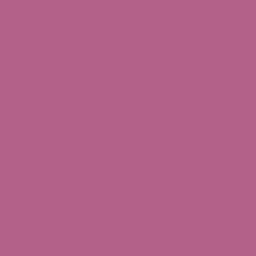
Sure enough, that's a PNG, but using save is disastrous to us for a few
reasons.
-
The image is written to the filesystem. To serve its contents to the client we'd have to read it from disk, which is SLOW.
-
Even if it wasn't slow we'd have concurrency issues. Clients could encounter half-written images or incorrect IP addresses from other clients.
-
Even if the above weren't issues, the
savemethod is written to assume synchronous I/O and Axum is an asynchronous web framework. We'd need to spawn a background task to keep it from blocking others.
Instead, ImageBuffer has a write_to method which
[w]rites the buffer to a writer in the specified format.
In this case a "writer" is some type, W, which implements the
Write and Seek traits. Rust's standard library gives us
such a W in the form of std::io::Cursor<T>. We can use a
Vec<u8> for our cursor's buffer type, T.
let mut cursor = Cursor::new(vec![]);
As for the "specified format", save has some logic to infer output format
from file extension, but with write_to we can just pass
ImageOutputFormat::Png.
img.write_to(&mut cursor, ImageOutputFormat::Png).unwrap();
The Vec<u8> wrapped by our cursor now contains all the bytes for a proper
(albeit blank) PNG. We can work with that Vec<u8> directly by consuming the
cursor with into_inner.
Serving the Image
At this point we need to tell Axum how to serve the image we've created. How do
we turn a Vec<u8> into a response that a client will understand as an image?
Axum knows how to serve Vec<u8> out of the box, but if we change the
handler's signature to return just that we'll have undesired behavior.
async fn avatar(ConnectInfo(addr): ConnectInfo<SocketAddr>) -> Vec<u8> {
// ..
cursor.into_inner()
}
Check that with curl and you'll see a response like
$ curl --head http://localhost:3000/avatar.png
HTTP/1.1 200 OK
content-type: application/octet-stream
content-length: 1726
date: Thu, 28 Dec 2023 02:30:17 GMT
Note that the Content-Type header is
application/octet-stream and not
image/png. We need analogs for PHP's header and imagepng in
order to tell the client the response is a PNG.
We could build an appropriate Response ourselves, but the
magic of Axum's IntoResponse trait provides a clear,
terse syntax for this that I find preferable.
async fn avatar(ConnectInfo(addr): ConnectInfo<SocketAddr>) -> impl IntoResponse {
// ...
([(header::CONTENT_TYPE, "image/png")], cursor.into_inner())
}
We return a tuple with an array mapping header names to values and the bytes
for the body. Axum's blanket implementations for IntoResponse do all the
work to figure out how to turn that into an HTTP response.
Putting it all together our current handler looks like this.
async fn avatar(ConnectInfo(addr): ConnectInfo<SocketAddr>) -> impl IntoResponse {
let _text = format!("Hello,\n{}", addr.ip());
let img = ImageBuffer::from_pixel(WIDTH, HEIGHT, BACKGROUND_COLOR);
let mut cursor = Cursor::new(vec![]);
img.write_to(&mut cursor, ImageOutputFormat::Png).unwrap();
([(header::CONTENT_TYPE, "image/png")], cursor.into_inner())
}
The _text is notably being ignored right now. We can get IP addresses, we
can create PNGs, and we can serve them. Now what remains is to put the text in
the image.
Adding Text
For the Rust analog of PHP's imagettftext we need a way to draw text on our
image. The image crate doesn't provide any routines for manipulating text,
but it does recommend the imageproc crate, which is maintained
by the same organization.
$ cargo add imageproc@0.23.0
This crate provides a draw_text_mut function, which will
draw text onto an existing image. From its signature we can gather it needs a
whopping 7 arguments (PHP's imagettftext is 8, so maybe I shouldn't
complain). Naturally, these aren't really documented, but we can learn a lot
from Rust signatures alone.
canvas— Any type that implementsimageproc'sCanvastrait.color— AnyPixelwhich can be drawn on thatcanvas.x— The x-coordinate at which to start drawing the text.y— The y-coordinate at which to start drawing the text.scale— TheScaleof the font face used when drawing the text.font— TheFontthe text should be drawn in.text— The text itself.
That feels like a lot, but we already have most of what we need. Luckily our
existing ImageBuffer satisfies the Canvas trait and we already know it's
using Rgb pixels which satisfy the Pixel trait. The x and y coordinates
were given in the original PHP and we already have our _text. We only need a
Scale and a Font. To work with both we'll need the rusttype
crate.
$ cargo add rusttype@0.9.3
Getting a Font
The font used in the original PHP was Ubuntu Mono, which is freely available for download. We just need to put the file alongside our Rust code.
In PHP-land with imagettftext we just specified the path to a TrueType font
file (UbuntuMono-Regular.ttf) and went on our merry way. Our Rust libraries
want us to create a Font, which requires us to load the contents of that
font file into our application.
We could do this on every request, which I think is what the PHP does. Or, we
could do one better and bake the font directly into our application with Rust's
include_bytes! macro. I threw in the concat! and
env! macros as well for completeness.
const FONT_DATA: &[u8] = include_bytes!(concat!(
env!("CARGO_MANIFEST_DIR"),
"/fonts/UbuntuMono-R.ttf"
));
// ...
let font = Font::try_from_bytes(FONT_DATA).unwrap();
Unfortunately, while the FONT_DATA can be const the Font itself
can't, but we can work with this for now.
Setting a Scale
The last piece of information we need to draw text is a font Scale. According
to the docs the scale is defined in pixels. However, PHP's
imagettftext specifies a size in points. The difference between
pixels and points is a tricky business, but for our
purposes we can take the Easy Mode ™ route by assuming that a point is
defined at a 3:4 ratio to a pixel. Thus, from the original font size of 24 we
arrive at a scale of 32.
const SCALE: Scale = Scale { x: 32.0, y: 32.0 };
Putting It All Together
With Font, Scale, and all our other arguments in hand we can finally draw
text on the image.
const X: i32 = 8;
const Y: i32 = 96;
const WIDTH: u32 = 256;
const HEIGHT: u32 = WIDTH;
const TEXT_COLOR: Rgb<u8> = Rgb([235, 219, 178]);
const BACKGROUND_COLOR: Rgb<u8> = Rgb([177, 98, 134]);
const SCALE: Scale = Scale { x: 32.0, y: 32.0 };
const FONT_DATA: &[u8] = include_bytes!(concat!(
env!("CARGO_MANIFEST_DIR"),
"/fonts/UbuntuMono-R.ttf"
));
async fn avatar(ConnectInfo(addr): ConnectInfo<SocketAddr>) -> impl IntoResponse {
let text = format!("Hello,\n{}", addr.ip());
let font = Font::try_from_bytes(FONT_DATA).unwrap();
let mut img = ImageBuffer::from_pixel(WIDTH, HEIGHT, BACKGROUND_COLOR);
draw_text_mut(&mut img, TEXT_COLOR, X, Y, SCALE, &font, &text);
let mut cursor = Cursor::new(vec![]);
img.write_to(&mut cursor, ImageOutputFormat::Png).unwrap();
([(header::CONTENT_TYPE, "image/png")], cursor.into_inner())
}
That handler will get us an image that looks something like this.
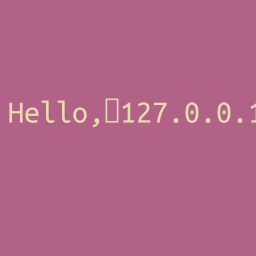
Which... doesn't really look right, does it? What the heck is the □ and why
is the IP address cut off instead of being on a new line?
Handling Newlines
We find the answer, as we often do, by reading more closely. draw_text_mut's
docs clearly say
Note that this function does not support newlines, you must do this manually.
That also offers an explanation for what the □ is. By digging into the
imageproc source we can see that it ultimately calls
Font::glyph, which says
Note that code points without corresponding glyphs in this font map to the “.notdef” glyph, glyph 0.
Since the newline character \n is a control character
it's not in the font itself and thus we get the .notdef glyph
instead. This also explains why the rusttype crate (and by extension
imageproc) doesn't support newlines.
So how can we "do this manually"? Neither imageproc nor rusttype offer any
specific advice. The easiest approach seems to be to just split the text up
ourselves and draw what goes on the next line with a new y offset.
let ip = addr.ip();
draw_text_mut(&mut img, TEXT_COLOR, X, Y, SCALE, &font, "Hello,");
let y = Y + SCALE.y as i32;
draw_text_mut(&mut img, TEXT_COLOR, X, y, SCALE, &font, &format!("{ip}!"));
I chose to just add SCALE.y to the original Y, which is playing fast and
loose with concepts like line height, but seems to work out well
enough. At last, we can reproduce the original PHP with output that looks
something like this.
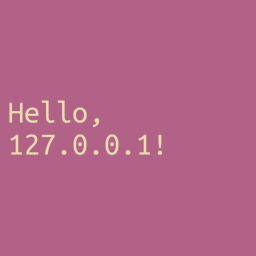
Room for Improvement
I've not gone back and run an old Apache instance, so I can't say with 100% certainty that we've got a pixel perfect replica of the original, but I think it's darn close. There's still more to think about though. Here's a grab bag of potential improvements, some I've made and some I've saved for another day.
Using One Font
Earlier I mentioned that our Font couldn't be const. That's true, but with
a little effort it can at least be static. I don't always love globals, but
it feels silly to create a new Font on each request when it could be the same
darn font every time.
I initially thought to use the lazy_static crate for this
purpose, but since Rust 1.70.0 stablized OnceLock I thought I'd
give that a try. Why not use a standard library approach if you can?
Until LazyLock stablizes it seems like the most ergonomic use of
OnceLock for what we want involves creating an accessor function.
use std::sync::OnceLock;
fn font() -> &'static Font<'static> {
static FONT: OnceLock<Font> = OnceLock::new();
FONT.get_or_init(|| Font::try_from_bytes(FONT_DATA).expect("Built-in font data was invalid"))
}
At the call site we just swap a &font for a font() and we're done. One
Font.
Normally I avoid potential panics as much as I can, but the only way
that Font::try_from_bytes can fail is if the .ttf
file is invalid at compile time, so I felt comfortable using
expect.
Error Handling
Yeah, the PHP just uses or die, but this is Rust, so we should try harder.
A panic in a completely unrecoverable situation which indicates your software
was built wrong seems acceptable for now, but we should fix all of our
unwrap calls. While not strictly necessary, it helps to have good
supporting libraries.
$ cargo add anyhow@1.0.78
$ cargo add thiserror@1.0.53
Server Errors
The unwraps in main can be neatly ?'d out of existence
with anyhow and Result in main. If they
fail the program can't reasonably continue, but we should try to exit cleanly
and allow an admin to read something about what happened.
#[tokio::main]
async fn main() -> anyhow::Result<()> {
let app = Router::new().route("/avatar.png", get(avatar));
let listener = tokio::net::TcpListener::bind("0.0.0.0:3000").await?;
let make_service = app.into_make_service_with_connect_info::<SocketAddr>();
axum::serve(listener, make_service).await?;
Ok(())
}
Handler Errors
The remaining unwrap in avatar benefits from a more careful approach. If
converting one ImageBuffer into a Vec<u8> fails for a single request the
whole application shouldn't crash. This failure point comes from
img.write_to(&mut cursor, ImageOutputFormat::Png).unwrap();
The write_to method returns a Result<T, E> whose E is an
ImageError. Unfortunately, it's not quite as simple as
returning Result<impl IntoResponse, image::ImageError> from our handler.
Trying to do so yields a rare and disappointing mystery compilation error too
long to reproduce here.
After sleuthing in Axum's error handling docs you can
discover that the Err variant for a Result should implement IntoResponse
itself. Frustratingly, our application code owns neither the ImageError
type nor the IntoResponse trait, so Rust's orphan rules
prevent us from implementing this directly ourselves. The easiest solution is
to make a wrapper.
#[derive(Debug, thiserror::Error)]
#[error("Failed to generate image: {0}")]
struct AvatarError(#[from] image::ImageError);
The thiserror crate makes this blessedly straightforward. An
AvatarError wraps an ImageError and can automatically be converted from one
thanks to the ease of #[from].
impl IntoResponse for AvatarError {
fn into_response(self) -> axum::response::Response {
(StatusCode::INTERNAL_SERVER_ERROR, self.to_string()).into_response()
}
}
Having to implement this trait for our own error makes a little more sense now. Without it how could Axum have known that this particular error should be an Internal Server Error?
Now we're allowed to define our handler as
async fn avatar(
ConnectInfo(addr): ConnectInfo<SocketAddr>,
) -> Result<impl IntoResponse, AvatarError> {
// ...
}
and we can use ? just like we hoped to.
IPv6 Support
Until now we've assumed that everything is using IPv4, but it's the tail end of 2023, so we should probably at least think about IPv6. Unfortunately things get ugly in a hurry.
In fairness though, I'm not sure how well the original PHP's
<?php
$ip = explode('.', $_SERVER['REMOTE_ADDR'], 4);
?>
handled IPv6, so this is well off the beaten path.
Allowing IPv6 Connections
With what's been written so far if you try to make an IPv6 connection you're gonna have a bad time.
$ curl -6 http://localhost:3000/avatar.png
curl: (7) Failed to connect to localhost port 3000: Connection refused
This is because we told the server to listen on
0.0.0.0 as a special shorthand for "listen on
all network interfaces". 0.0.0.0 is specific to IPv4, so we aren't listening
for any incoming IPv6 connections. We can fix that by listening on
::, the IPv6 equivalent.
let listener = tokio::net::TcpListener::bind("[::]:3000").await?;
I've wrapped the :: with [] because it helps readability by disambiguating
between : as part of the address and : as an address/port separator. Also
because RFC 2732 said so.
Listening on an IPv6 fixes the problem and also still works for IPv4... kinda... Apparently the exact semantics are OS-dependent. On Windows it only binds for IPv6 and on Linux it's dependent on kernel configuration.
I think in order to make it work in both Windows and Linux you'd have to
- Listen on
::. - Also listen on
0.0.0.0. - Spawn two tasks, each with their own copy of the app, and put
them in a
JoinSet. - Hope and pray (or check) that
/proc/sys/net/ipv6/bindv6onlyis set, otherwise Linux will get mad at you because it's already listening on both.
I couldn't be bothered. I'd choose to run the application on Linux and I control the kernel, so it's working for me. 🤷♂️
Displaying IPv4 Correctly
Just because we can accept IPv4 and IPv6 connections doesn't mean it's actually
working the way we want it to though. Letting :: bind both IPv4 and IPv6 has
another side effect. IPv4 addresses are interpeted as IPv4-mapped IPv6
addresses.
If you curl via IPv4 specifically with
$ curl -4 -O http://localhost:3000/avatar.png
you're likely to see something like this.
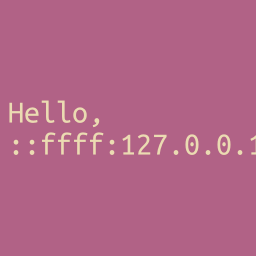
In this form an IPv4 address like 127.0.0.1 is represented in an IPv6 address
format like ::ffff:127.0.0.1. The IPv4 form is the "canonical" form. Luckily
Rust's IpAddr type has a method for this,
to_canonical.
let ip = addr.ip().to_canonical();
This was actually just added in Rust 1.75.0 mere days ago, well after I started writing this. You can just take my word that this was rather more of a pain in the ass to deal with before that.
IPv4 works again!

IPv6 also works!
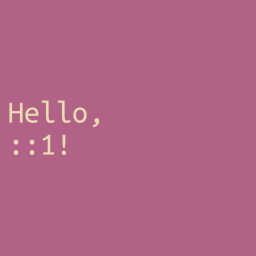
Haha, just kidding, it absolutely does not. Most IPv6 addresses are way longer
than ::1.
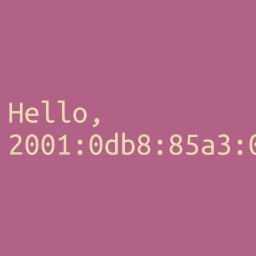
Displaying IPv6 Correctly
Out of all the problems we've dealt with so far I think this is the thorniest. Unlike with the newline issue, the text simply doesn't fit in the image. At this font size, if you get a real-world IPv6 address you're more than likely going to draw it right off the edge of the canvas.
Just decrease the font size, you might say...
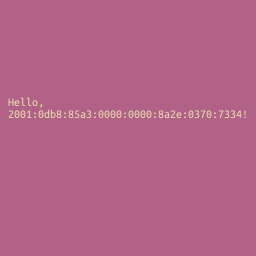
Your eyes must be better than mine. That's not easy to read. I had to set the
Scale to 12.0 to make that fit. It looks even sillier with ::1, I
promise.
OK, well just make the PNG wider then!
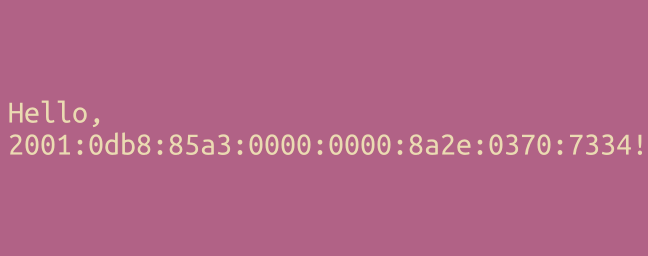
Cool, now it's 648 pixels wide. If you're reading on mobile it might well
exceed the width of your screen. It also looks silly with ::1, btw.
Additionally, it likely violates an original constraint that the image be 256 x
256 pixels to serve as a profile picture.
Uhh... why are you making this so complicated? We did newlines before, wrap the text!
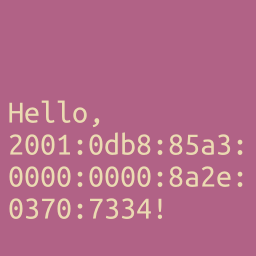
Huh. Actually, I don't hate that, but it no longer looks centered. Also, IPv6
addresses aren't guaranteed to have a uniform length. There are
several different ways to represent them. For example,
2001:0db8:0000:0000:0000:8a2e:0370:7334 can also be written as
2001:db8::8a2e:370:7334. Furthermore, RFC 5952 recommends that
Leading zeros MUST be suppressed.
and
The use of the symbol "::" MUST be used to its maximum capability.
so if we play by the rules different addresses might take up a different number of lines. Really, both width and height could be variable depending on our solution.
Is There Nothing We Can Do?
We've considered 3 solutions, all of which have their own issues.
- Shrinking the font size.
- Mostly illegible.
- Increasing the image width.
- Looks awkward for variable width addresses.
- Likely violates an original constraint for 256 x 256 pixels.
- Wrapping the text.
- Looks awkward for variable lines.
Of the 3 solutions I think text wrapping is the most appropriate, but I ran out of time to pursue an implementation before writing this. I feel comfortable leaving a solution as an exercise to the reader and would love to hear what others would do.
SVG
I'm sure that by now at least one person has been screaming "Use SVG!" in their mind. Personally, I'm not convinced it's necessarily a better fit, but it's not something I know much about, so I'm open to being wrong.
I applied what little I know to create an SVG.
<svg width="256" height="256" xmlns="http://www.w3.org/2000/svg">
<style>
@font-face {
font-family: "Ubuntu Mono";
src: url(/fonts/UbuntuMono-Regular.ttf) format('truetype');
}
</style>
<rect width="100%" height="100%" fill="#b16286"/>
<text x="8" y="96" font-size="24" font-family="Ubuntu Mono" fill="#ebdbb2">
<tspan x="0" dy="1em">Hello,</tspan>
<tspan x="0" dy="1em">127.0.0.1!</tspan>
</text>
</svg>
I left the font out for this particular image, but it yields something like this.
Here are my observations given what I assume about SVGs, PNGs, and this problem.
Benefits
- The font looks smoother as a vector graphic than in a raster image when zoomed in.
- The SVG above is all of 435 bytes for the client to download.
- Supports font fallback if the font can't be downloaded.
- You can copy the text out of it!
Downsides
- The SVG might be 435 bytes, but the
.ttffile is ~205KB. Most PNGs in this post are <10KB. - Neither newlines nor line wrapping in general appear to be solved, at least
not in
text. - Likely would not have been supported by the original target client.
I don't see the benefits hugely outweighing the downsides, especially when keeping in mind what likely would have been the original constraints. What we've got should do for now.
The Finished Product
I can't believe you read this far. The final code is available on GitHub, but this post didn't feel complete without putting everything I talked about in one place for comparision with the PHP.
It's significantly longer than the original and probably more complicated than it needs to be, but it mostly works and that's worth something.
use std::{io::Cursor, net::SocketAddr, sync::OnceLock};
use axum::{
extract::ConnectInfo,
http::{header, StatusCode},
response::IntoResponse,
routing::get,
Router,
};
use image::{ImageBuffer, ImageOutputFormat, Rgb};
use imageproc::drawing::draw_text_mut;
use rusttype::{Font, Scale};
const X: i32 = 8;
const Y: i32 = 96;
const WIDTH: u32 = 256;
const HEIGHT: u32 = WIDTH;
const TEXT_COLOR: Rgb<u8> = Rgb([235, 219, 178]);
const BACKGROUND_COLOR: Rgb<u8> = Rgb([177, 98, 134]);
const SCALE: Scale = Scale { x: 32.0, y: 32.0 };
const FONT_DATA: &[u8] = include_bytes!(concat!(
env!("CARGO_MANIFEST_DIR"),
"/fonts/UbuntuMono-R.ttf"
));
#[derive(Debug, thiserror::Error)]
#[error("Failed to generate image: {0}")]
struct AvatarError(#[from] image::ImageError);
impl IntoResponse for AvatarError {
fn into_response(self) -> axum::response::Response {
(StatusCode::INTERNAL_SERVER_ERROR, self.to_string()).into_response()
}
}
fn font() -> &'static Font<'static> {
static FONT: OnceLock<Font> = OnceLock::new();
FONT.get_or_init(|| Font::try_from_bytes(FONT_DATA).expect("Built-in font data was invalid"))
}
async fn avatar(
ConnectInfo(addr): ConnectInfo<SocketAddr>,
) -> Result<impl IntoResponse, AvatarError> {
// Wow, IPv6 causes a lot of headache. 😵💫
let ip = addr.ip().to_canonical();
let mut img = ImageBuffer::from_pixel(WIDTH, HEIGHT, BACKGROUND_COLOR);
draw_text_mut(&mut img, TEXT_COLOR, X, Y, SCALE, font(), "Hello,");
let y = Y + SCALE.y as i32;
draw_text_mut(&mut img, TEXT_COLOR, X, y, SCALE, font(), &format!("{ip}!"));
let mut cursor = Cursor::new(vec![]);
img.write_to(&mut cursor, ImageOutputFormat::Png)?;
Ok(([(header::CONTENT_TYPE, "image/png")], cursor.into_inner()))
}
#[tokio::main]
async fn main() -> anyhow::Result<()> {
let app = Router::new().route("/avatar.png", get(avatar));
let listener = tokio::net::TcpListener::bind("[::]:3000").await?;
let make_service = app.into_make_service_with_connect_info::<SocketAddr>();
axum::serve(listener, make_service).await?;
Ok(())
}
Thanks for reading! Maybe I'll learn to write smaller posts next year. 🤣